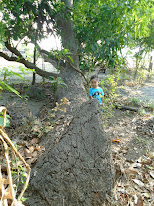The Arboretum*
Living with Nature Center
Microcosm of a Tropical Forest
Dr Abe V Rotor
This towering native mango is more than four generations old. It dominates several heritage trees which include talisay (Terminalia catappa), caimito (Chrysophyllum cainito), and macopa (Eugenia jambalana), and other upcoming heritage trees in the arboretum. On its limbs and branches hang lianas and epiphytes like rosary bead (Abrus precatorius), philodendron, ferns, bromeliads, mosses and lichens. The tree in itself is an ecosystem, complete in biodiversity and dynamic balance season after season in a state of homeostasis.
A grove of heritage trees makes a fort-like wall against strong wind,
flood and erosion - and irritating noise. (Trees are excellent buffers
of sound.) It is the home of arboreal animals like gecko lizard,
bats, tree frogs, sparrows, wild honeybees, moths and butterflies,
other arthropods notwithstanding. The trees also serve as seasonal
host to migrating birds like tarat, panal and perperocka, and
occasionally martinez, black crow and kingfisher, and hawk.
Heritage palm trees - anahaw (Livistona rotundifolia) and betel nut (Areca catechu) - rise as emergents through the canopy of the arboretum. They are the abode of bats, resting during the day
under their drooping broad leaves - a perfect base for their
nocturnal habit.
University of Northern Philippines students tour the arboretum
for their outdoor research and extension studies.
On-the-spot painting contest under the trees is a rare experience of children from different schools of the Municipality of San Vicente, Ilocos Sur, in celebration of Earth Day last April 22, 2023, sponsored by LGU
and the Living with Nature Center.
My grandchildren - Mateo, Mackie and Markus - enjoy their summer
vacation in the arboretum, a different kind of adventure to the
young city-bred generation.
A flimsy canopy of treetops allows sunlight to penetrate
and nourish the small trees, shrubs and ground plants.
This explains the dense vegetation of rainforests. The
deciduous nature of most tropical trees, that is, seasonal
shedding of leaves, enhances this phenomenon.
Clearing in between trees is maintained regularly for outdoor
workshops and study tours for house guests and study groups.
Trees are robust and green throughout the year, and are most noticeable in the dry season, thus trees are the refuge of many organisms, from birds to reptiles - and even fish and amphibians - when the surrounding fields and ponds are virtually dry.
They filter the direct rays and heat of the sun, dusts, spores, and radiation. Breeze, mist and dew keep temperature and humidity stable.
Music of nature - chirping of birds, shrill of cicada, fiddling of crickets, rustling of leaves, bass of toads and frogs - all these constitute a soothing and harmonious symphony. Mozart's Effect must have originated in such ambiance, so with Beethoven's famous symphony, Brahms's Lullaby and Grieg's Prelude to Morning.
Music of nature - chirping of birds, shrill of cicada, fiddling of crickets, rustling of leaves, bass of toads and frogs - all these constitute a soothing and harmonious symphony. Mozart's Effect must have originated in such ambiance, so with Beethoven's famous symphony, Brahms's Lullaby and Grieg's Prelude to Morning.
The Parthenon of Greece must have its origin from the imagination
of our ancestors who saw the beauty and grace of standing trees reaching for the sky. Nature is indeed the greatest architect, and
man is but her student.
The built-in knots, twists and crevices on trees are natural homes of lizards, bees, ants, birds, and the like. They also serve as rivulets and waterholes that catch and store rain and dew, serving as arboreal pond for dragonfly naiads, tadpoles, and even certain species of fish. Shown here are macopa (Eugenia jambalana) and palomaria trees (Callophyllum inophyllum), which are among the heritage trees in the arboretum.
In Latin, an arboretum is a place planted with trees, not necessarily in this specific sense, and "arboretum" as an English word is first recorded used by John Claudius Loudon in 1833 in The Gardener's Magazine, but the concept was already long-established by then. Wikipedia
























No comments:
Post a Comment